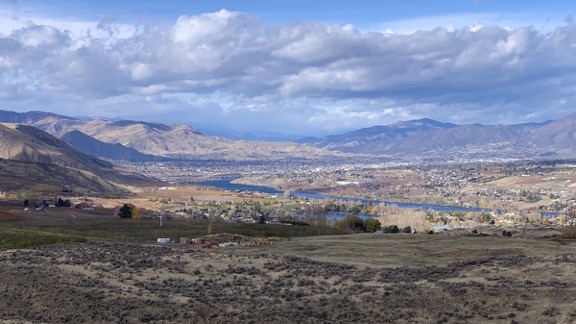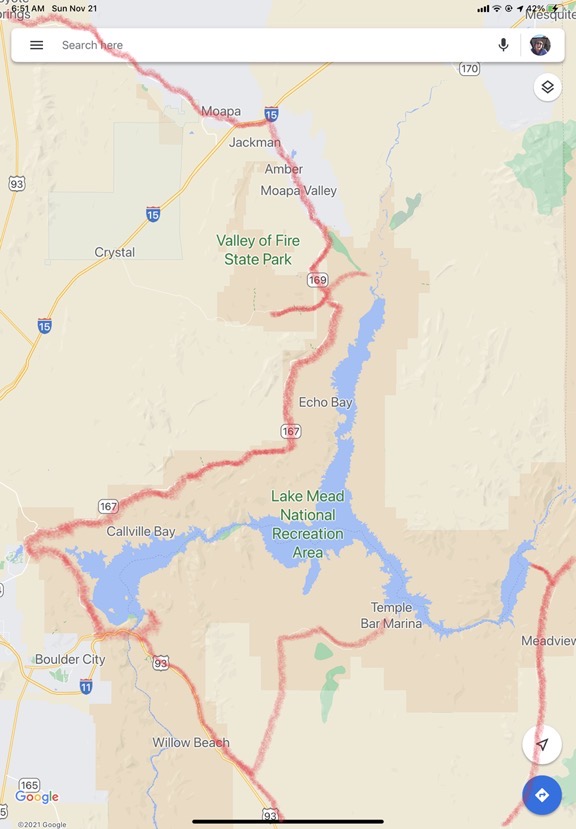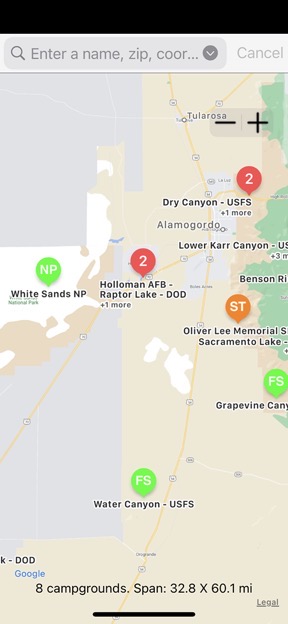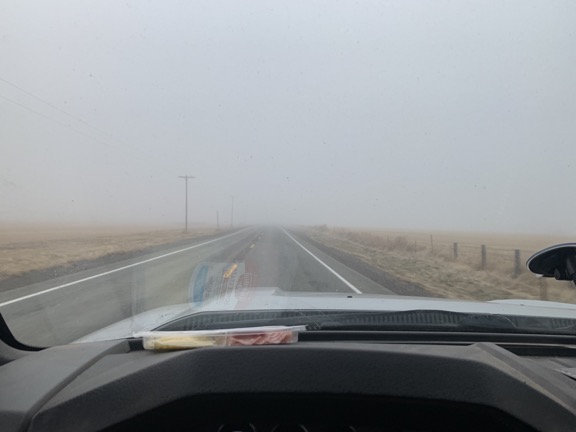Some details about the places I camped during my winter 2021/22 trip to points south.
I thought I’d keep track of the places I camped each night in case anyone wants to try any of them.
Edited February 17, 2022:
Where I am now/just added: Navaro Beach Camp, , CA.
| Place | Cost | Hookups | Facilities | Connect | Comments |
|---|---|---|---|---|---|
| Three Islands State Park, ID | $36* | E ** | G ** | C | *Rate includes non-ID surcharge. **Water turned off for season. |
| Pahranagat National Wildlife Refuge, NV | free | none | T G * | C | *Multiple pit toilets. Lakeside sites. Wildlife, hiking/biking trails. Close to road. |
| Valley of Fire State Park, NV. Atyl Campground. | $35* | E W ** | T S G | *** | *Rate includes non-NV surcharge. **Dump station only. ***WiFi available for a fee. Nice sites, quiet, red rocks. Good value. |
| Lake Mead National Recreation Area, NV. Stewart’s Point. | free | none | T* | C | *Pit toilets in one area. Huge area right on the lake. Many campers but lots of space. Quiet, private. |
| Lake Mead National Recreation Area, AZ. Willow Beach Campground. | $57* | E W S ** | T S L G R | W *** | *Rate includes Good Sam discount and tax. **Sewer on site and at dump station. ***Free WiFi for one device. Overpriced but very pleasant. 50% off 65+ with pass. |
| Lake Mead National Recreation Area, AZ. Kingman Wash | free | none | T * | C | *One central pit toilet. Quiet, underutilized, early sunset because of canyon, 3 miles down gravel road. You can camp right on the lake. Coyotes, burros. |
| Lake Mead National Recreation Area, NV. Six Mile Cove | free * | none | T G * | C *** | *Park entrance fee or pass is required. **Central pit toilets. ***Weak come-and-go cell signal. Quiet (on weekdays), 30 minute drive down gravel road from park entrance station. You can camp right on the lake. Beware of soft sand in parking area. |
| Davis Camp. Bullhead City, AZ | $36.25* | E W ** | T S G | C | *Includes extra fee for dogs and tax. **Dump station. County park campground on Colorado River just downstream from Davis Dam. |
| Oatman-Topock Dispersed BLM Camping | free | none | none | C* | *Usable Cell phone signal on Verizon. Close to road, rugged terrain. |
| Needle Mt Road BLM Dispersed Camping | free | none | none | C* | *Usable Cell phone signal on Verizon. Relatively close to freeway, rugged terrain. |
| Lake Havasu State Park, Overflow Camping Area | $25.00 | * | T S G | C | *Dump station available. Limited number of beachfront sites. Inadequate generator rules. |
| Pomosa Road Dispersed Camping, Quartzsite, AZ | free | none | none | C* | *Usable Cell phone signal on Verizon. Very quiet. |
| Holtville Hot Spring BML Long Term Camping area | $40.00* | none | T S** G | C | *$40 covers up to 14 consecutive days in this and other long term areas. **Toilet and shower are at the hot spring. No soap allowed. Relatively flat, featureless area with dispersed camping. Lots of long term campers with expansive solar setups. |
| New Camp, Salton Sea Recreation Area | $37 * | E W ** | T S*** G R | C | *Rate includes $7 reservation fee. **Dump station only. ***Shower was solar hot water, $1/token. Hookup campsites were either in a large parking area or adjacent to main road with railroad track nearby. Camp store closed. I would not camp there again; not worth the money. |
| Joshua Tree South BLM Dispersed Camping | free | none | none | C | Large area along maintained gravel roads just south of Joshua Tree National Monument. Many campers, but plenty of space. Easy access to I-10 freeway about 1 mile away. Remarkably quiet. |
| Rice Ranch, Quartzsite AZ | $40* | E W S | G | C** | *Somewhat discounted rate due to past business relationship. **Strong signal but slow due to heavy load on local cell towers during Quartzsite’s busy period. Centrally located very near two main venues, bicycling distance to all others. At noisy intersection. |
| A Friend’s House, Gilbert, AZ | $0 | n/a | n/a | n/a | Every year I visit with some friends in Gilbert, AZ. I stay in their guest room and let my camper sit empty in their driveway. The last night of my stay, they had more houseguests so I moved into the camper for the night, still parked in their driveway and not hooked up to utilities. |
| USFS Apache Jct Dispersed Camping | $0 | none | none | C* | *Cell signal was acceptable but not good. Wide open area not far from off-road vehicle recreation parking. Shooting within 1/2 mile before dark and before dawn in the morning. Coyotes. Two late arrivals slept in their vehicles and departed before light, which was kind of weird. Beautiful desert. |
| Catalina State Park, Tucson (Ringtail area dry camping) | $20 | none* | T S G R | C** | *Dump station available. **Cell signal was acceptable but not good. Nice park with many hiking, biking, and equestrian trails. Dog friendly. Main campgrounds offer electric and water at sites; nearly impossible to reserve. |
| Casino Del Sol RV Park, Tucson, AZ | $56 | E W S | T S L G | C W* | *Wifi near central building only. New campground with asphalt parking surrounded by gravel. Newly planted trees. No ambiance at all, but plenty of amenities. Expensive. |
| Las Cienegas National Conservation Area | $0 | none | none* | C | *Pit toilets available in group camping areas. Active historic cattle ranch(es) with dispersed camping. |
| A friend’s house, Sierra Vista, AZ | n/a | n/a | n/a | n/a | My Gilbert friends have a new second home in Sierra Vista and invited me to check it out. We stayed two nights and I helped them with a few of their renovation chores. It was wicked cold those two nights and I was glad to be indoors. |
| BLM Darby Wells Road Dispersed Camping, Ajo, AZ | $0 | none | none | C | Dispersed camping in Sonoran desert just south of an open pit copper mine. |
| Holtville Hot Spring BML Long Term Camping area | $40.00* | none | T S** G | C | See notes from first stay. I stayed for another 6 nights in February. |
| Mojave Narrows County Park, Victorville, CA | $39 | E W S | T S G | C | County campground right next to TWO train tracks. Sites were dirty, land was poorly kept. Other campers were loud, but train was worse; it ran all night. NOT recommended. |
| Gaviota Lane, Ventura, CA | $0 | none | none | none | Relatively quiet side street behind a strip mall with an apartment complex across the street. |
| Jalama County Beach Campground, Lompac, CA | $50 | none* | T S G R | W** | *I picked one of the beachfront sites which had no hookups. Other sites had hookups. There was a dump station. **No cell signal at all; WiFi was iffy. Very nice campground 14 miles down a twisty road. |
| Limekiln State Park, Lucia, CA | $35 | none | T S G R | none | Tiny campground tucked into a canyon under a bridge. Some sites are near the beach; others are in a dense wooded area next to a creek. No cell signal. Quiet. Pleasant stay but being out closer to the beach would have been nicer. |
| Bay Flat Road, Bodega Bay, CA | $0 | none | none | C | Recommended to me by campground host at full Bodega Dunes Campground. Pullout alongside the road right on the bay. Quiet except for fog horn, barking sea lions, and some traffic. |
| Navaro Beach Campground | $35 | none | T* G | C** | *Pit toilets. **Very weak cell signal on Verizon was enough to check in at social media and send/receive texts. Pleasant campground adjacent to a beach. Just 10 sites include table and fire ring. Very quiet. |
Key to codes
| Hookups | Facilities | Connectivity |
|---|---|---|
| E – Electric W – Water S – Sewer | T – Toilet S – Shower L – Laundry G – Garbage R – Recycle | C – Usable Cell Signal (Verizon) W – Free WiFi |





